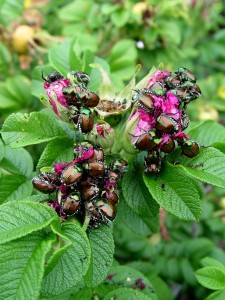July

An orgy of Japanese beetles making short work of rose blooms.
- Watch for Japanese beetles. They’re the biggie pest of the month. Hand-pick, repel with neem oil or mint-based sprays or use a traditional insecticide if they’re really bad. Beetle traps usually make the problem worse unless everyone else around you is also using them. If you’re the only trapper, they’re all coming your way.
- Also scout for and treat if necessary for bagworms on evergreens and shade trees; galls on spruce; slugs on hosta; spider mites on spruce and other evergreens; lacebugs on azaleas and pieris; mimosa webworm on honeylocusts, and scale on euonymus. Remember: No spraying in the hot afternoon sun or whenever temperatures are over 85 degrees.
- Keep plants well watered – especially newly planted plants – if rain isn’t sufficient. July is usually the hottest, driest month. Early-morning and early-evening watering is best.
- Especially check pots and hanging baskets daily for water. Turn them a quarter of a turn every few days to keep growth uniform and upright (not one side leaning to the sun). Fertilize containers at least weekly at half-strength for best results.
- Hire a waterer or rig up a timer and sprinkler (or drip-irrigation system) if you’re going away on vacation. This is especially important for containers and new plantings. Another trick is setting pots in a shallow container of water; they’ll take up water through the drainage holes and buy you a day or two without watering.
- Monitor junipers for phomopsis blight and mildew– and leaf-spot-prone plants for leaf disease. Treat if needed. Also check yourself for ticks after working outside.
- Stop pinching back mums after the first week of July.
- Continue deadheading spent annual flowers and trim off spent flower stalks of perennials after they bloom.
- Pull weeds in beds and spot-spray for weeds in lawn. Do not feed or weed-‘n-feed the lawn this month, especially if the lawn has gone brown and dormant.
- Grub preventers such as Merit (imidacloprid) can be applied to the lawn this month if you didn’t apply it in June. Milky spore is an organic alternative against Japanese beetle grubs that’s somewhat effective but slow to take hold.
- Monitor lawns for chinch bug and sod webworm damage. Use lawn insecticide if needed.
- Neaten hedges and evergreens with light prunings.
- Harvest vegetables and replant space with beans, carrots, beets or cucumbers. Start seeds of broccoli, cabbage and cauliflower for a fall crop.
- New perennials, trees and shrubs can still be planted so long as you keep them well watered.
- Continue feeding aquatic plants and fish. Trim overgrown marginal plants and keep pond topped off.
- Prune fruited raspberry canes to the ground once they’ve finished fruiting this season.
- Remove suckers (sprouts from the roots) from around crabapples and other fruit trees.
- Continue spraying program for fruit trees and roses.
- Cover up or use sunscreen liberally and often if you’re planning to work outside for more than a few minutes. Also don’t forget to check for ticks.
- End of July is the ideal time to prune mophead/bigleaf (macrophylla-type) hydrangeas.







